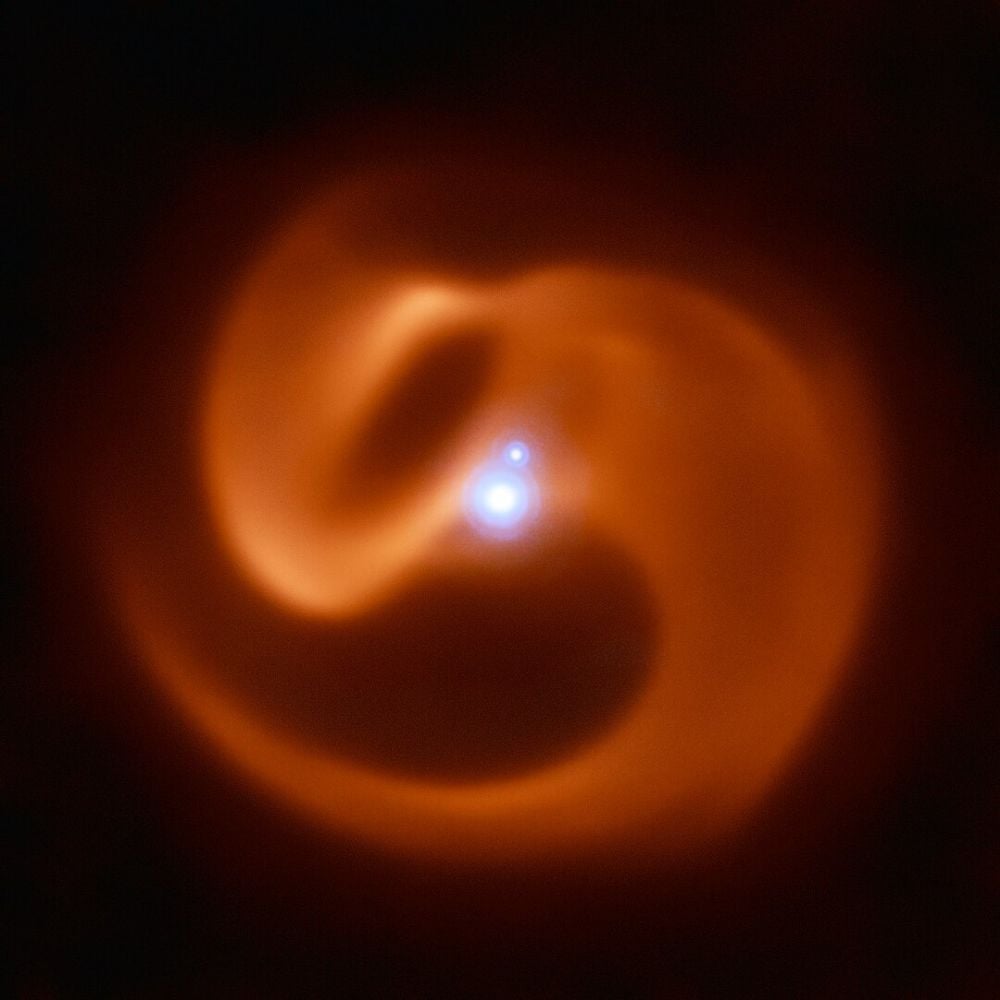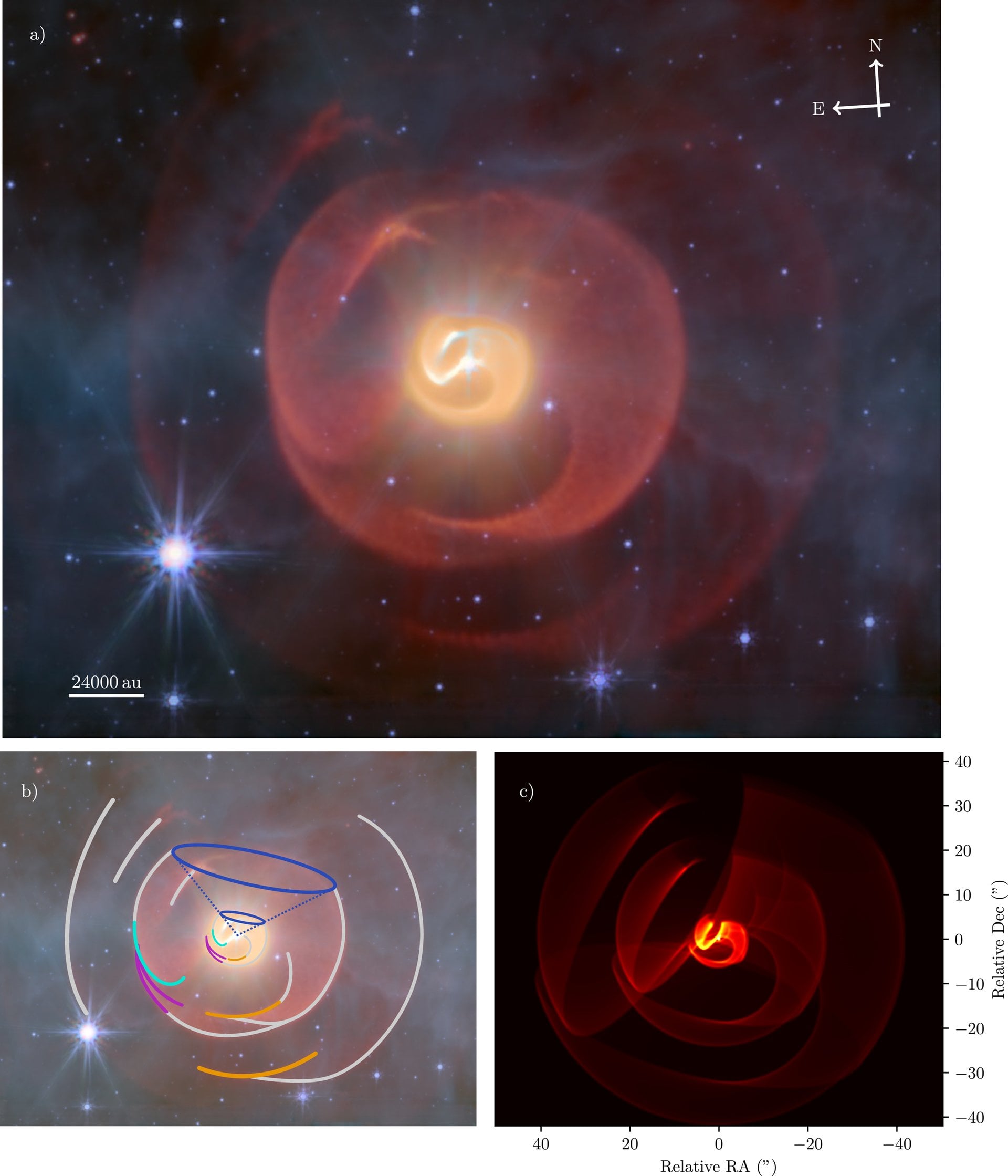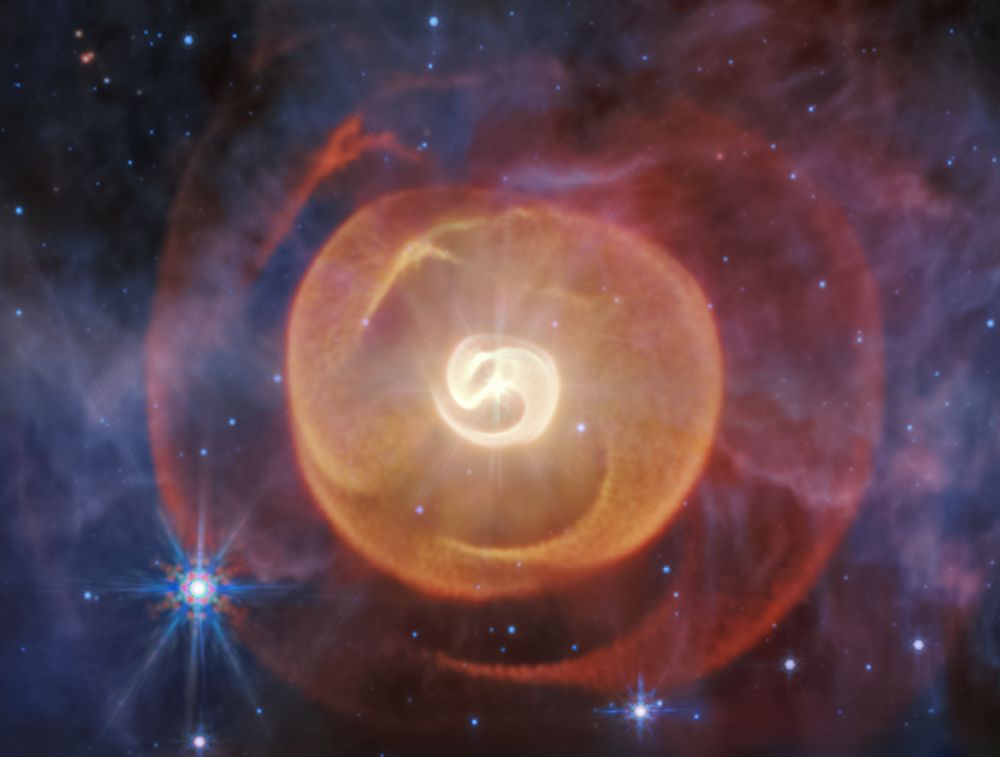In multiple ways, the JWST is opening our eyes to the Universe. It’s enriching our understanding of the cosmos by showing us things we didn’t think were possible, and by uncovering more details in things that have been observed many times by lesser telescopes.
One of these subjects is called Apep, a triple star system about 15,000 light years away. Apep is home to a binary pair of Wolf-Rayet stars and a third supergiant star. The WR stars orbit each other about once every two centuries, while the much smaller companion is about 1,700 au away and takes more than 10,000 years to complete a single orbit.
The JWST’s MIRI instrument captured new images of Apep that show four serpent-like dust swirls around the system. In the image, the fourth one is nearly transparent and is at the edge of the frame. Previous images showed only a single shell.
 *The ESO’s Very Large Telescope captured this image of the Apep system. The larger light source in the middle is the pair of WR stars, and the smaller source is the third member of the system, a supergiant star. This image is far less detailed than the new JWST image. Image Credit: By ESO/Callingham et al – Coils of Apep by European Southern Observatory (image URL), CC BY 4.0, https://commons.wikimedia.org/w/index.php?curid=74554810*
*The ESO’s Very Large Telescope captured this image of the Apep system. The larger light source in the middle is the pair of WR stars, and the smaller source is the third member of the system, a supergiant star. This image is far less detailed than the new JWST image. Image Credit: By ESO/Callingham et al – Coils of Apep by European Southern Observatory (image URL), CC BY 4.0, https://commons.wikimedia.org/w/index.php?curid=74554810*
The new image isn’t just for our visual enjoyment. It’s part of an effort to understand Wolf-Rayet (WR) stars. They’re rare stars that are extremely hot and highly evolved. They’ve shed their outer hydrogen layers and are busy fusing helium. They create a lot of carbonaceous dust and astrophysicists want to understand how they function.
New research in the Astrophysical Journal examines Apep for clues to how WR stars work. It’s titled “The Formation and Evolution of Dust in the Colliding-wind Binary Apep Revealed by JWST,” and the lead author is Yinuo Han. Han is a post-doctoral researcher in the Division of Geological and Planetary Sciences at the California Institute of Technology.
“Looking at Webb’s new observations was like walking into a dark room and switching on the light — everything came into view,” said lead author Han in a press release. “There is dust everywhere in Webb’s image, and the telescope shows that most of it was cast off in repetitive, predictable structures.”
“Carbon-rich Wolf–Rayet (W-R) stars are significant contributors of carbonaceous dust to the galactic environment; however, the mechanisms and conditions for formation and subsequent evolution of dust around these stars remain open questions,” the authors write. They describe Apap as a “W-R+W-R colliding-wind binary,” and emphasize the intricate detail in the substructure of the nested, concentric dust shells.
The shells exhibit a striking regularity, suggesting that a repeating mechanism is responsible for their formation. But the powerful JWST has also shown us the subtle differences between the shells. “The concentric dust shells show subtle deviations from spherical outflow, which could reflect orbital modulation along the eccentric binary orbit or nonsphericity in the stellar wind,” the authors write.
Another paper in the Astrophysical Journal is also based on the JWST’s image of Apep. It’s titled “The Serpent Eating Its Own Tail: Dust Destruction in the Apep Colliding Wind Nebula,” and the lead author is Ryan White from the School of Mathematical and Physical Sciences at Macquarie University, Sydney, Australia. White is also a co-author on Han’s paper, and Han is a co-author on White’s paper.
Astronomers have been uncertain if the companion supergiant star is part of the WR binary system, but the JWST images show that it is. “I was shocked when I saw the updated calculations play out in our simulations,” White said. “Webb gave us the ‘smoking gun’ to prove the third star is gravitationally bound to this system.”
The third supergiant star is on a much wider orbit, and repeatedly carves holes in the dust shells. “The cavity is more or less in the same place in each shell and looks like a funnel,” White said. The funnel is from the 10 o’clock to the 2 o’clock position coming from the central point of light.
 *(a) is a false-color composite image of the Apep nebula made by combining data from the JWST’s F770W, F1500W, and F2550W filters. (b) highlights the concentric shell structure with a gray skeleton, where the colored ridges indicate regions of interest. (c) shows the geometric fit to Apep’s three visible shells. Image Credit: White et al. 2025. ApJ*
*(a) is a false-color composite image of the Apep nebula made by combining data from the JWST’s F770W, F1500W, and F2550W filters. (b) highlights the concentric shell structure with a gray skeleton, where the colored ridges indicate regions of interest. (c) shows the geometric fit to Apep’s three visible shells. Image Credit: White et al. 2025. ApJ*
“Multiepoch Very Large Telescope/VISIR and JWST/MIRI observations show that this northern companion star routinely carves a cavity in the dust nebula—the first time such an effect has been observed in a CWB—which unambiguously associates the O star as a bound component to the Apep system,” White and his co-authors explain.
The pair of WR stars were once much more massive than they are now. They’ve shed much of their mass and are now around 10 or 20 solar masses each. The companion supergiant star is about 40 or 50 solar masses. The triple star system and its intricate dust shells may not last much longer, in astronomical terms. The WR stars will eventually explode as supernovae. The blast will wipe away this tableau, and the stars could possibly form black holes.
WR stars are rare, and there are only about 1,000 of them in the Milky Way. A few hundred have been found in binary relatioships, but Apep is the only known binary pair where both stars are WR stars.
While the image of Apep and its dust shells is visually compelling, it also shows astronomers something about how WR stars create dust and spread it into their surroundings. And as a very rare WR binary with a third companion, it’s a natural laboratory that can tell astrophysicists about the evolution of these rare stars.
In their conclusion, White and his co-authors explain that the WR pair have an orbital period of 190 years, an order of magnitude longer than other similar pairs. This, along with confirmation that Apep is a triple star system, “… cements Apep as a singular astrophysical laboratory for studying colliding winds and the terminal life stages of the most massive star systems,” the authors explain.
WR stars like the binary pair in Apep are important producers of carbonaceous dust. The colliding winds create the conditions for dust to coalesce, and this dust enriches the interstellar medium (ISM) with carbon and contributes to its enrichment with other heavier elements. But Apep’s third star, the supergiant, is also destroying some of this dust.
“The creation and processing of dust grains into the ISM influences all areas of astronomy, and the binary W-R stars together with the dust-destroying O supergiant at the heart of the Apep nebula cements it as a truly unique astrophysical laboratory,” the researchers conclude.

